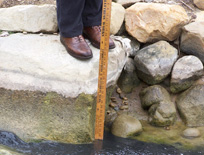Water-in-Transit Pond Problem

Understanding how to move water from one level to another is among the most surprisingly complex challenges in all of watershaping. Indeed, there are lots of ways to get into trouble – even if you’re confident that your design is correct.
Case in point: I was called in as an expert witness by California’s Contractor State License Board to investigate a project in which a contractor had convinced his clients that the dry river bed running across their property could easily be turned into a functioning waterfall, stream and pond without much effort or expense.
The client loved the idea and naively agreed simply to pay whatever it cost to have the work done. The contractor came back with a price of $18,000, which probably would’ve been fine had the contractor had the slightest idea what he was doing when it came to water in transit.
Scenario: The waterfall and stream traced a path about 80 feet long, descending a slope that rose to a neighboring property. There were three collection basins along its course, and it emptied into a 20-by-20-foot pond at its base. From the pond, the contractor used a pair of four-horsepower sewage pumps to push the water back to the waterfall.
When the pumps were activated, it took seven or eight minutes for the system’s top basin to fill completely and overflow. Unfortunately, the volume of water needed to initiate the falls lowered the pond’s level by a good 14 inches – a visual consequence the client didn’t like at all. To accommodate the differential and handle evaporative losses, the contractor installed a mechanical auto-fill system plumbed to the home’s main line. The unit operated with a large arm-and-ball valve – similar to what you’d find in a toilet, except the ball float was about the size of a basketball!
So as the pumps were moving water up the system, the auto-fill system would dutifully fill the bottom section of the pond back up at the same rate that water was being pushed up the slope. Amazingly, the contractor hadn’t considered that when the pumps were turned off, the water in the waterfall system would empty back down into the bottom pond, which would consequently overflow and send about a foot of water over the edge and into an adjacent downhill property.
Simply stated, the contractor had no understanding at all of surge capacity and its requirements. So his solution was simply to run the pumps all the time. Needless to say, having those big pumps running constantly – with no way to turn them off without causing a flood – was a ludicrous solution. It ignored, for example, the fact that pumps ultimately require service, repair and replacement and that running a pair of four-horsepower pumps in perpetuity is both wasteful of energy and quite costly in the long run.
Any number of better fixes were available to the contractor, including a design in which the catch basins along the watercourse would have captured enough of the flow along the streambed to avoid the flooding problem. Even easier would have been including a surge tank at the bottom of the system to accept the water in transit – or perhaps coming up with a pond design in which aesthetics wouldn’t suffer too much from a dramatic drop in water level (although that would have been asking too much in this case).
If the contractor had been more educated by perhaps reading WaterShapes or attending a pond design and/or water-in-transit seminar, he might also have developed a system in which dramatic waterfall and stream effects were achieved using relatively small volumes of water. For example, pieces of flagstone combined with cobble can be used to disperse thin sheets of water over wide, natural-looking (but low-flow) weirs. In nature, in fact, you’ll often see small rivulets of water flowing over large rock formations – an observation that should tell us that more isn’t always better!
Lesson Learned: We all have made mistakes, but if you’re unsure, consult an expert and don’t casually take on a project when you have no idea how to deal with the basics – such as, in this case, the fact that water actually flows downhill and always needs someplace to go.
Scott Cohen is president and supervising designer of The Green Scene, an outdoor design and construction firm based in Northridge, Calif. He provides consultation for clients nationwide and gives seminars on designing landscapes, swimming pools and outdoor kitchens. For more information, go to www.greenscenelandscape.com.










